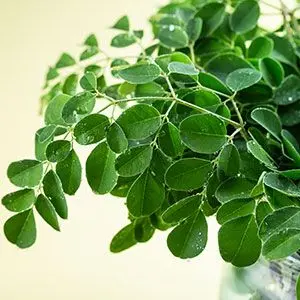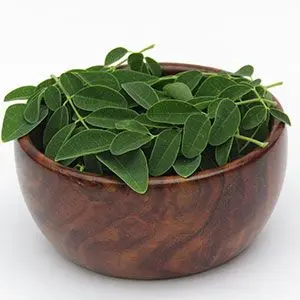Moringa: Could This Leafy Green Be Your Pet's New Superfood?
With small, rounded leaves packed with nutrients and phytochemicals, this vegetable has grown in popularity in recent years because of its healing properties. Here's how it can benefit your pet's health.

STORY AT-A-GLANCE
- Moringa is called “the miracle tree” because of its diverse nutritional profile and health benefits
- It’s an excellent source of bioactive compounds, including flavonoids and phenolic acids that have a wide range of pharmacological properties
- Moringa also exhibits high superoxide dismutase (SOD) activity; SOD is a powerful enzyme responsible for eliminating free radicals in your pet’s body
- You can use fresh or lightly cooked moringa leaves as a topper to your pet’s nutritionally balanced, species-appropriate homemade meal, or as an ingredient to a homemade pet treat recipe
- Moringa is loaded with essential vitamins and minerals, including vitamin C, beta-carotene (pro-vitamin A), calcium, iron and potassium, all of which support your pet's immune health, bone strength and overall well-being
Editor's Note: This article is a reprint. It was originally published May 5, 2023.
Have you ever heard of moringa or tried adding it to your meals? This leafy plant has been gaining recognition as a superfood — and for good reason. It’s rich in nutrients and bioactive compounds that give it potent healing properties, which can benefit not just you but also your pet. Continue reading to learn how moringa can help enhance your pet’s health and how to add this leafy vegetable to their diet.
What Is Moringa?
Also known as drumstick tree or horseradish tree, moringa (Moringaceae) is a genus of medicinal plants that grows 25 to 35 feet tall, with a foliage of small leaflets attached to thin branched stems. There are about 13 species of moringa, but the most widely cultivated, consumed and studied species is moringa oleifera.1,2
Almost every part of the moringa plant, from its leaves and flowers to its pods and seeds, is edible and revered for its therapeutic potential.3 In fact, moringa is also called “the miracle tree” because of its diverse nutritional profile and health benefits.4 Due to its growing popularity, moringa is now sold in different forms, including dried or powdered moringa leaves, moringa capsules and tea.5
If you happen to find fresh moringa leaves and other plant parts at your local farmers market, they can be eaten raw or cooked and used just like any vegetable — added to soups, stews, salads, main dishes and even to your pet’s nutritionally balanced, species-appropriate diet.
Moringa Fun Fact

Moringa leaves have a distinctly “green” flavor that’s bitter and slightly sweet, described as “matcha that has been spiked with notes of spirulina-like blue-green algae.”6 Moringa pods, on the other hand, taste similar to green beans but sweeter.7
Flavonoids in Moringa Exert Potent Pharmacological Actions
Moringa is an excellent source of polyphenolic compounds, including flavonoids. According to a study published in the journal Antioxidants (Basel), “The main flavonoids found in [moringa] leaves are myricetin, quercetin and kaempferol, in concentrations of 5.8, 0.207 and 7.57 mg/g, respectively.”8
These flavonoids have a wide range of pharmacological properties. Kaempferol, for example, exhibits antioxidant, anti-inflammatory, anticancer, cardioprotective and antimicrobial effects, among others.9 Animal studies have also demonstrated its neuroprotective effect and ability to protect the integrity of the blood-brain barrier.10
As for myricetin, it has antioxidative, antidiabetic, anticancer, cardioprotective, anti-inflammatory and hepatoprotective properties.11 In a study published in the Journal of Cellular Physiology, researchers evaluated the effects of myricetin in the treatment of canine osteosarcoma and found it induces apoptosis (cell death) in canine osteosarcoma cells.12
Just like kaempferol and myricetin, quercetin is known for its potent antioxidant and anti-inflammatory actions as well, in addition to other pharmacological properties. Quercetin also demonstrated neuroprotective effects against Alzheimer’s disease in animal models by “ameliorating learning and memory functions,” according to a study in the International Journal of Molecular Science.13
Other Bioactive Compounds That Add to Moringa’s Benefits
“Another group of phytochemicals found in moringa is phenolic acids, which have antioxidant, anti-inflammatory, antimutagenic and anticancer properties.”14
The most abundant phenolic acid in this leafy veggie is gallic acid,15 which has been shown to improve lipid metabolism and gut health in healthy dogs upon long-term consumption.16 Moringa is also rich in chlorogenic acid, which regulates blood glucose metabolism and exerts anti-dyslipidemic actions on animal models.17
In addition, moringa exhibits high superoxide dismutase (SOD) activity.18 SOD is a powerful enzyme responsible for eliminating free radicals in your pet’s body by catalyzing the breakdown of superoxide radicals into oxygen and hydrogen. Superoxide radicals are harmful to your pet’s cells, so removing them is critical to keep your pet’s lymphatic system functioning optimally.19,20,21
Did You Know?

Moringa is distantly related to broccoli, kale, cauliflower, collard greens and other members of the Brassica family, as it’s categorized as a cruciferous vegetable.22
This Leafy Veggie Is Loaded with Vitamins and Minerals
Moringa is a powerhouse of vitamins and minerals that play important roles in your pet’s essential body functions. According to a study published in the International Journal of Food Science:23
“Moringa is said to provide 7 times more vitamin C than oranges, 10 times more vitamin A than carrots, 17 times more calcium than milk, 9 times more protein than yoghurt, 15 times more potassium than bananas, and 25 times more iron than spinach.”
While pets can synthesize their own vitamin C, getting this nutrient from fresh food sources may benefit their well-being. Vitamin C is known for its powerful free radical scavenging action, which may help reduce inflammation and support immune function. It also plays a role in skin health and cognition.24,25
Moreover, moringa contains beta-carotene (pro-vitamin A), which exhibits antioxidant action and may help improve immune health and reduce the risk of degenerative diseases, including heart disease, macular degeneration and cancer.26
As for this plant’s mineral content, calcium is essential for bone health as well as muscle and nerve function,27 while iron is necessary for growth and development, red blood cell production and transporting oxygen throughout your pet’s body.28 Potassium, on the other hand, is vital for proper cell, nerve and muscle function.29
Moringa Has an Edge When It Comes to Sustainability
Another advantage to adding moringa to your family’s diet is that you’ll be eating an eco-friendly crop. Researchers have even looked into its potential to be a “sustainable climate-smart solution to nutrition, disease prevention, and water treatment challenges.”30
Because moringa is one of the fastest growing trees in the world31 and has an extensive root system, it can help sequester large amounts of atmospheric carbon dioxide. It’s also frequently grown without chemical fertilizers and pesticides, as it’s a hardy plant that can thrive even in poor soils, with bitter compounds that make it unpalatable to insects.32
With that said, if you’re looking for fresh moringa leaves and other plant parts, opt to buy from your local farmers market whenever possible. When buying moringa products like tea and powdered leaves, make sure to buy from certified organic, spray-free sources.
Where Does Moringa Grow?

Moringa is native to South Asia, growing on the Himalayan foothills. Some species are also endemic to Africa. Nowadays, moringa trees are widely cultivated across tropical and subtropical countries, including South East Asia, Latin America and the Caribbean.33 In the U.S., moringa is grown in California and Florida.34,35

How to Prepare Moringa and Serve It to Your Pet
When you buy fresh moringa, the leaflets will still be attached to the stalk. It can be time-consuming to pluck each leaf by hand, so try these methods instead:
- Lightly grip a stalk with your forefinger and thumb. Then in one smooth stroke, slide the length of the stalk between your fingers to strip off the leaves.
- Wrap the leaves in a dry newspaper and shake it lightly to separate the leaves from the stems.
- Pull the stems through the holes of a strainer or colander to strip off the leaves.
Since it’s easier to pluck the leaves when they’re dry, rinse them after stripping them from the stalk. You can use fresh leaves as an ingredient in a homemade pet treat recipe or add lightly cooked moringa leaves as a topper to your pet’s meals. You can also add the leaves to an onion-free broth for your pet or serve it in pureed form, mixed with other pureed healthy fresh foods. Another option is to spread the pureed form on a lick mat or add it to an interactive toy. Moringa tea can be used to rehydrate dehydrated or freeze-dried pet foods.
As for moringa pods, they’re cooked and served similar to green beans — steamed and chopped into bite-sized morsels. As always, remember to limit the serving of healthy “extras” like this to less than 10% of your pet’s daily caloric intake.
Sources and References
- 1,31 The Spruce, June 24, 2024
- 2,8,14,15,17 Antioxidants (Basel). 2017 Nov 16;6(4):91
- 3,33 Food and Agriculture Organization of the United Nations, Moringa (Archived)
- 4,23 Int J Food Sci. 2021 Aug 10;2021:6627265
- 5 The Spruce Eats, March 25, 2020
- 6 Vogue, May 3, 2017
- 7 NPR, September 21, 2015
- 9 Mini Reviews in Medicinal Chemistry, Volume 11, Number 4, 2011, Pages 298-344(47)
- 10 Front Pharmacol. 2021 Jan 13;11:565700
- 11 Food Science & Nutrition Volume 9, Issue 10, Pages 5854-5868
- 12 Journal of Cellular Physiology, Volume 233, Issue 9, Pages 7457-7466
- 13 Int. J. Mol. Sci. 2020, 21(2)
- 16 Food Chemistry: X, Volume 15, 30 October 2022, 100377
- 18 Int J Mol Sci. 2011 Sep 19;12(9):6077–6088
- 19 J Cell Biol. 2018 Jun 4;217(6):1915–1928
- 20 Int J Health Sci (Qassim). 2018 May-Jun;12(3):88–93
- 21 Cell Biochem Funct. 1999 Mar;17(1):15-9
- 22 Nutrients. 2018 Mar 12;10(3):343
- 24 American Kennel Club, March 14, 2024
- 25 Whole Dog Journal, April 24, 2021
- 26 ScientificWorldJournal. 2016 Oct 19;2016:7393620
- 27 NIH Office of Dietary Supplements, Calcium
- 28 NIH Office of Dietary Supplements, Iron
- 29 MedlinePlus, Definitions of Health Terms: Minerals
- 30 Journal of Agriculture and Food Research Volume 10, December 2022, 100397
- 32 FoodPrint, Moringa
- 34 NutraIngredients, January 11, 2016
- 35 Naples Daily News, August 5, 2017











